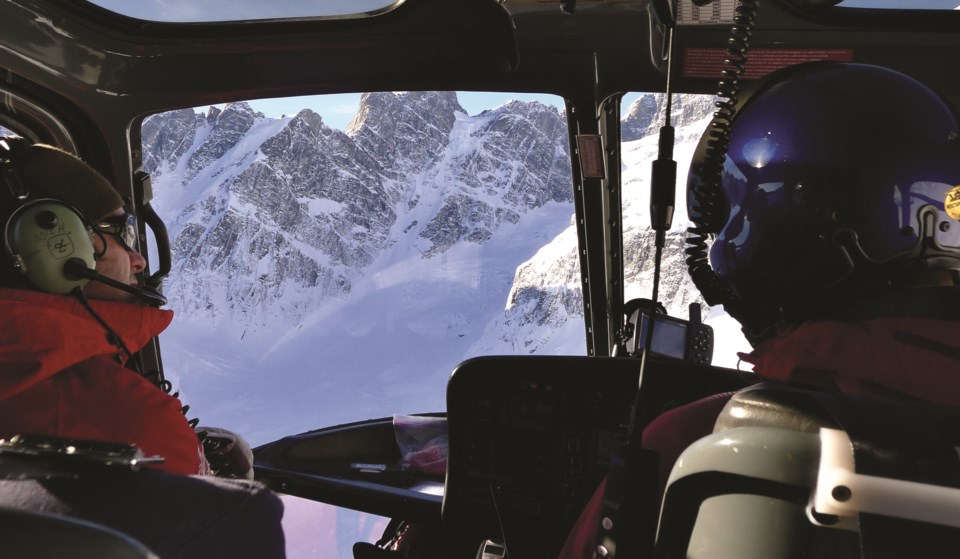A few years ago, on a bluebird winter day, breakfast wrapped up quickly. Along with a second round of eggs benedict came the all clear to fly until the North Pacific’s next meteorological tantrum arrived. Skiers scattered excitedly for the cabins fronting historic Tweedsmuir Lodge outside the Central Coast town of Bella Coola. Soon, groups of four-plus-guide had assembled at flagged landing areas, and the whup-whup of rotor-wash echoed from the valley’s rocky walls. It was go-time at Bella Coola Heli Sports (BCHS).
Starting on snowy pillows close to the lodge, each subsequent lift staged us farther out onto long, languishing glaciers and the ridges that cradled them. There were no complaints about the snow: it was the kind that could change your life. Around noon, we flew into a glacier-gouged valley where a scalloped forest edge traced the phantom shoreline of a one-time lake that had drained—as though someone suddenly pulled a plug—into the craggy labyrinth below. Landing beside the heavily fractured Jacobsen’s Glacier, we skied knee-deep powder on a 100,000-year-old base, mindful of the apartment-block ice tumbling in suspended animation beside us.
When we went around again, I recalled the short plane ride from Vancouver, where the view had revealed a torture of mountains and valleys swirling in every direction. At its centre, the Monarch Icecap stretched between peaks like a sheet pulled taut on a giant bed, with scrunched-blanket glaciers rippling at its corners. Now, standing at its edge, the scale was surreal. Here, amidst peaks so titanic they warped puny human perspectives, films like K2 and Seven Years in Tibet were shot, while first descents and unnamed runs lurked on every horizon.
The high-fiving that ensued after each run confirmed this paean to discovery, but the loud, loquacious group I was with seemed particularly excited. And with good reason: the terrain was theirs, so to speak. BCHS founders Christian Begin, Pete “Swede” Mattson, and Beat Steiner were not only enjoying an infrequent day out together, but a last hurrah; after 20 years, Begin and Mattson were moving on while Steiner remained to steer the ship. But not before they’d received just recognition for their efforts: the World Ski Awards had just ranked BCHS the No.1 Heli-ski Operation in the World. High praise, it was also validation for the three amigos who’d forged their friendship in the active outdoor filmmaking industry around Whistler.
In the late 1990s, Begin and Steiner were cinematographers with a string of high-profile movie credits, while Swede guided their backcountry shoots. Searching for a less-crowded venue, their eyes were widened by the mountains around Bella Coola, and they made a deal with a funky 1920s hunting-and-fishing lodge to pay a fee for every head they brought in. “You could barely drag tourists here in the summer and suddenly we were bringing in people in the winter,” recalls Swede. “No one in town really knew what was going on above treeline because they’d never been up there—it was all a bit mysterious.”
It was a long, hard road to become heli-skiing’s ne plus ultra destination, but more than mountains made BCHS special: there was also the deep history and culture of the Nuxalk First Nation, excellent fishing, and abundant wildlife. The musty, kitsch-filled Tweedsmuir Lodge was eventually renovated as central hub of a base constellated with high-end cabins, hot tub, sweat lodge, fitness room and firepit. The culinary and wine offerings ratcheted up, and they expanded into the Pantheon Range surrounding Mt. Waddington—B.C.’s highest peak at 4,019 metres—capping an astonishing 3.25 million-acre tenure to which they added more exclusive, small-group bases—Eagle Lodge, Pantheon Heli Ranch, Mystery Mountain Lodge. Then, just as they were getting good at it, someone had decided they were the best.
Having carried that title four-years running as of 2020, it’s hard to imagine the operation relinquishing it—particularly given BCHS’ recent addressing of heli-skiing’s obvious carbon profligacy by becoming the world’s first “climate-positive” heli-ski operation, purchasing offsets that help preserve old-growth forest while supporting local First Nations and educational platforms that encourage others to fight climate change.
Pinned down as predicted by the next storm on that long-ago trip, we kept busy with pool games, fishing, mountain biking, visits to Nuxalk mask-carvers, and hikes to the Polynesian-like petroglyphs of Thorsen Creek—once speculated over by no less than Norwegian explorer Thor Heyerdahl. Frisbee golf, archery, hot-tubbing and hilarity filled the interstices. In the lodge, Begin held forth on the revolutionary nature of BCHS’s original A-star B2 helicopter program, one of the first to carry four to five guests as opposed to the 12-person industry standard—a taxi versus bus approach. “We saw small-group heli-skiing as the future,” he’d said. “Now it’s the standard.”
When the storm dissipated the next morning, we started again on the same nearby pillows, finding them 60 centimetres fluffier than our last visit. We skied big glaciers until lunch then bumped out to a zone called Cloudbreak, where the great skiing became magnificent—snow so intoxicating we lingered until the horizon flamed crimson.
In the end, it was one of the best ski days of my life. And though that didn’t automatically qualify BCHS as the world’s best heli-ski destination, another transcendent day in incomparable mountains was pretty convincing.
Leslie Anthony is a Whistler-based author, editor, biologist and bon vivant who has never met a mountain he didn’t like




